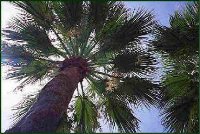California Fan Palm Tree
Detailed Description
Description
Stately and distinctive, the California Fan Palm is one of the most
widely grown palms in subtropical climates. California Fan Palm can grow
60' tall with a crown spread of 15'. The massive gray trunk is barrel
shaped and ringed with old leaf scars, and may reach over 3' in diameter
at its widest point. It can have up to thirty gray-green palmate
(fan-shaped) leaves, each 3-6' across. They spread out to form a loose
and open crown. The petioles (leaf stems) of mature palms are armed
along the margins with curved thorns; those of young palms are largely
unarmed. The individual leaflets are pendulous and swing freely in the
wind. Abundant cotton-like threads on and between the leaflets persist
even when the palm is mature. If old leaves are not removed, they form a
continuous "petticoat" from the crown all the way to the ground. The
California Fan Palm produces numerous branching flower clusters that
project out and often downward from the leaf crown. The bisexual
blossoms are white and yellow and give rise to oblong or round red-black
fruit, each about a half inch in diameter. The fruits of California Fan
Palm contain a single seed, approximately 1/4" in diameter.
Usage
Plant California Fan Palm outdoors in a site that can accommodate the
large head of leaves, and is not directly under power lines or other
structures. Use the California Fan Palm in natural and formal groupings
and in large open areas. It is perfect for street, avenue and parkland
planting where it typically is spaced about 30' apart. Young California
Fan Palms also can be grown in pots or tubs on decks or in indoor areas,
such as conservatories or atriums that have bright light.
Features
The California Fan Palm has numerous fine attributes including cold
hardiness, fast growth and drought and salt resistance. This palm is
inexpensive, adapts to most soils, is easy to grow and transplant, and
is very hardy. The genus was named in honor of George Washington. The
species name, filifera, comes from both Latin and Greek words
meaning thread-bearing.
